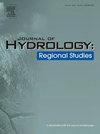揭示不断变化的气候条件下未来清洁水稀缺状况的诊断框架
IF 5
2区 地球科学
Q1 WATER RESOURCES
引用次数: 0
摘要
研究区域长江流域。研究重点清洁水短缺是人类可持续发展的主要制约因素之一。以往的缺水诊断主要关注人类需水量的波动,而忽视了气候变化背景下水质变化加剧的水资源供需失衡。本研究结合气候和社会经济预测、水文系统、环境要求和人类取水模拟以及水质预测,提出了未来气候预测下清洁水稀缺性分析的诊断框架。结果表明,到本世纪末,洁净水压力指数将大幅下降,可能受到洁净水短缺威胁的人口数量预计将从 2.948 亿减少到 1.591 亿。随着未来淡水资源的增加,清洁水稀缺的情况预计会有所缓解。根据情景模拟,结果进一步显示,在近期和远期,清洁水稀缺的缓解措施主要受自然因素的影响。这些结果证明,所提出的框架可以为评估和解释气候变化对清洁水稀缺的多方面影响提供一个新的视角。本文章由计算机程序翻译,如有差异,请以英文原文为准。
A diagnostic framework to reveal future clean water scarcity in a changing climate
Study region
The Yangtze River basin.
Study focus
Clean water scarcity is one of the major constraints for human sustainable development. Previous diagnosis of water scarcity has focus on fluctuations in the amount of water needed by humans, while ignoring the imbalance between water supply and demand that is exacerbated by changes in water quality under the context of climate change. This study proposes a diagnosis framework for clean water scarcity analysis under future climate projections by combining climate and socioeconomic projections, hydrological system, environmental requirement and human water withdrawal simulations, and water quality projections. This framework is demonstrated in analyzing the clean water scarcity for near (2031–2060) and far (2070–2099) futures.
New hydrological insights for the region
The results show that by the end of this century, the clean water stress index will decrease substantially, and the number of people potentially threatened by clean water scarcity is expected to decrease from 294.8 million to 159.1 million. Clean water scarcity is expected to ease as freshwater resources increase in the future. Based on scenario simulations, the results further reveal that mitigation measures for clean water scarcity are mainly affected by natural factors in near and far futures. These findings support that the proposed framework can provide a new perspective for assessing and explaining the multifaceted influences of climate change on clean water scarcity.
求助全文
通过发布文献求助,成功后即可免费获取论文全文。
去求助
来源期刊

Journal of Hydrology-Regional Studies
Earth and Planetary Sciences-Earth and Planetary Sciences (miscellaneous)
CiteScore
6.70
自引率
8.50%
发文量
284
审稿时长
60 days
期刊介绍:
Journal of Hydrology: Regional Studies publishes original research papers enhancing the science of hydrology and aiming at region-specific problems, past and future conditions, analysis, review and solutions. The journal particularly welcomes research papers that deliver new insights into region-specific hydrological processes and responses to changing conditions, as well as contributions that incorporate interdisciplinarity and translational science.
 求助内容:
求助内容: 应助结果提醒方式:
应助结果提醒方式:


